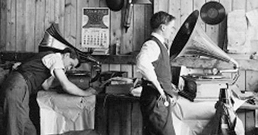In April 1909, a group of eight accomplished Iranian musicians and singers travelled to London at the invitation of the Gramophone Company. In the course of 12 days, they recorded more than 200 pieces of music, which are treasured as one of the earliest and most complete collections of vintage recordings of Persian music. This collection has played an important role in the study of the evolution of Persian music, particularly regarding the influence of western music and the use of western musical instruments. Two other visits before and after this were made by two separate groups who went to Paris and Tbilisi for the same purpose, but neither was as fruitful in terms of variety and quality, nor did their records survive.
Years before, the Qajar ruler, Nasseruddin Shah, had brought back to Tehran the ‘phonograph’ after his second visit to London. It was never used as a means of mass production of music as each of its cylindrical records had to be recorded separately. Moreover, high quality Persian music in that period was exclusively sponsored and enjoyed by the Court and the top echelons of the society, and was not accessible to the general public. This changed with the invention of the gramophone and flat discs by Emile Berliner in America in 1887, followed by the formation of his Gramophone Company there as well as in several other countries. Subsequently, the door was gradually opened for the mass production and distribution of records.
The Persian music recordings made in London by this company benefited from these developments and the greater accessibility provided by the gramophone. They were soon made available to the public in Iran, thus ending the monopoly of high quality music by the court and the elite. The collection can be divided into two distinctive parts, with two different combinations of musicians and instruments used in each. The pieces of music recorded in the first five sessions are played with traditional instruments such as the ‘taar’ and ‘santour’, whereas in the second set only western instruments such as the piano and violin are used.
Mohammad Reza Sharayeli, who is an expert in gramophone recordings, has carried out extensive research into these valuable archives. In this multimedia report, he tells us the background and the fascinating story of the production of these unique records.


